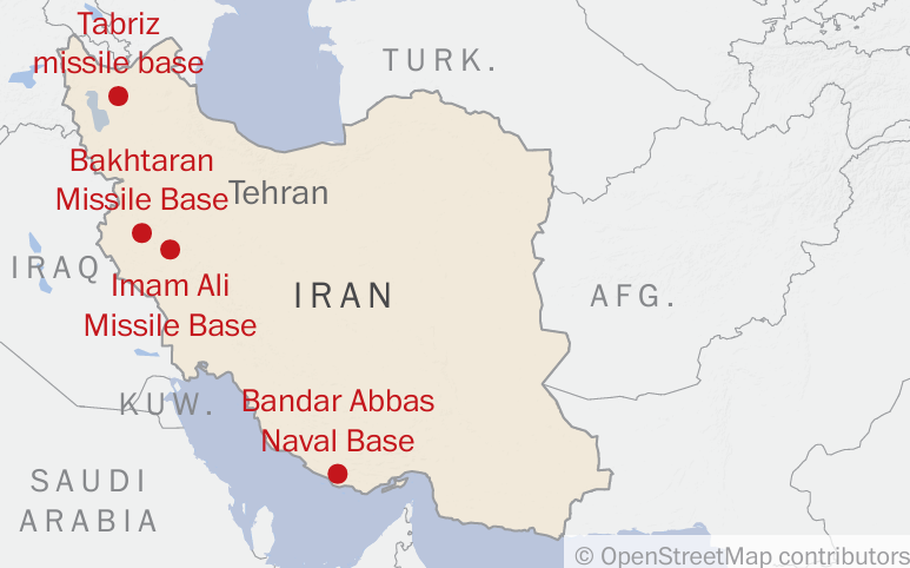
A map of potential military targets in Iran that could be struck by Israel in retaliation for the Iranian missile barrage in early October 2024, created by The Washington Post with OpenStreetMap contributors. (The Washington Post)
More than three weeks after Iran fired a barrage of missiles at Israel — some of which broke through Israeli air defense systems, with one landing near the headquarters of the country’s spy agency — Iran is bracing for retaliation.
Israeli Prime Minister Benjamin Netanyahu told President Joe Biden that Israel planned to strike Iranian military targets, rather than oil infrastructure or nuclear facilities, The Washington Post reported. Biden urged Israel not to target Iranian nuclear facilities and discouraged attacks on oil infrastructure, which could cause a spike in gas prices ahead of the Nov. 5 election.
Still, Israel has said its own “national interest,” not that of the United States, would decide the targets. Israeli Defense Minister Yoav Gallant said the Israeli retaliation would be “precise, painful and surprising.”
Here’s a look at some of the places in Iran that Israel could target.
Military sites
Israel may be inclined to strike military targets instead of oil or nuclear ones not just because of Biden’s urging, but because doing so could hamper future Iranian attacks, said Michael Allen, a partner at Beacon Global Strategies, a security advisory firm, and former National Security Council official in the George W. Bush administration.
“They’re not going to waste a bullet,” Allen said. “I think it’s going to be very purposeful targeting.”
Going after Iran’s launch sites would be the most logical option for Israel if it wants to degrade Iran’s abilities to strike back, Allen said.
Iran has a handful of launch sites, including the Tabriz, Bakhtaran and Imam missile bases in the west and Bandar Abbas in the south, according to the Nuclear Threat Initiative, a Washington think tank. The launch sites in the west are key, as they are closer to Israel.
Imam and Tabriz are underground missile silos, according to NTI, while Iran’s naval base is at Bandar Abbas.
The volume of missiles used in Iran’s attack this month — it sent at least 180 ballistic missiles hurtling toward Israel — may suggest that Iran also has more mobile launchers than previously thought, John Krzyzaniak, a researcher who studies Iran’s weapons programs at the Wisconsin Project on Nuclear Arms Control, previously told The Post.
Oil infrastructure
Biden has discouraged an attack on Iranian oil facilities. He said this month, in reference to the Israelis: “If I were in their shoes, I’d be thinking about other alternatives than striking oil fields.” Targeting oil infrastructure would create turmoil for Tehran, which relies heavily on oil revenue, according to the World Bank. But it would also inflict economic pain on the Iranian public, which Israel has sought to pit against its government. Netanyahu told Iranians that “Israel stands with you,” in a speech this month.
Iran’s oil infrastructure is also spread out and redundant, which could limit the impact of an attack, Farzin Nadimi and Simon Henderson, senior fellows at the Washington Institute, a D.C.-based think tank, argue in a recent article.
But the industry still has many vulnerabilities, Nadimi and Henderson write, namely a pipeline junction off Iran’s southwest coast, north of Kharg Island. The junction is a “convergence point for all the pipelines in southwest Iran, where the country’s main oil fields are located,” they write.
Targeting key infrastructure like pipeline junctions and pumping stations “could disrupt Iranian oil flows for weeks or even months,” according to Nadimi and Henderson, but attaining such a result would be a heavy lift for Israel because of the massive, potentially multipronged offensive that would be required to destroy the various facilities.
Nuclear facilities
Israel appears to have targeted Isfahan, a province south of Tehran, after Iran’s first direct attack on Israel, in April. Iranian state media reported that the country’s military intercepted “three small drones” in the province, which hosts a military base and nuclear research facilities.
Iran also has an enrichment plant in Fordow, between Tehran and Isfahan. The International Atomic Energy Agency, the U.N. nuclear watchdog, said in June it had been notified by Iran that it was planning on upgrading the facility. The IAEA said it had confirmed new construction activity there. The facility is underground, making it a more difficult target.
The Biden administration has strongly discouraged such an attack. Still, Iran’s foreign ministry spokesman said this week that Tehran has lodged a complaint with the IAEA over the potential for an Israeli attack on its nuclear sites, local media reported.